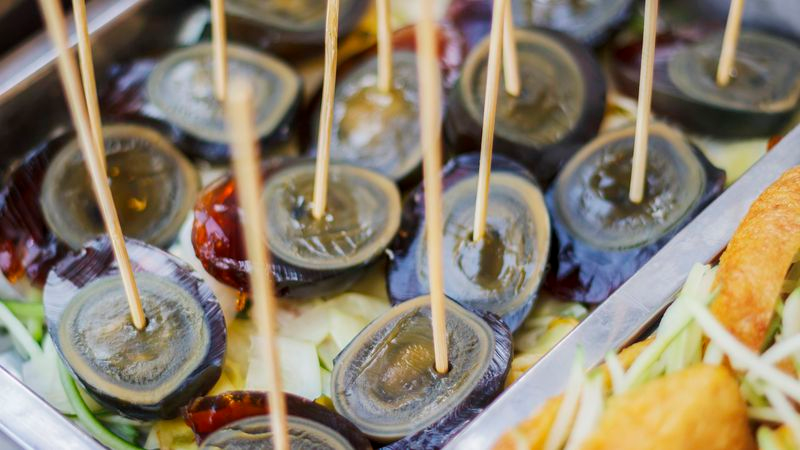The Ghastly-Looking Century Egg Is The Roquefort Of Chinese Foods
When I was little, I thought that century eggs (also known as hundred-year or thousand-year eggs, pidan in Mandarin, and "What the hell is that?!") were dinosaur eggs. Any 5-year-old could make the same assumption. There's the name, for one thing, and the fact that the eggs are sold covered in clay and rice hulls like they've been dug up during an archaeological expedition. And then there's the egg's appearance when peeled—the egg white is a soy sauce-colored translucent gelatin, and the yolk is greenish-black with a soft, gooey center, as though the egg has been cooked just shy of hard-boiled stage.
Century eggs taste like regular boiled eggs whose flavors have been supercharged. The gelatin doesn't taste much like anything, but the yolk is egg turned up to 11. It's rather like eating a ripe Camembert, pungent and creamy, with a whiff of ammonia.
A cousin of mine explained the smell by telling me that century eggs were made by soaking them in horse urine. That turned out to be a bunch of horse piss indeed, despite what the Thais and Laotians, who colloquially refer to century eggs as "horse urine eggs" in their respective languages, believe.

The smell actually comes from the ammonia that's produced when the eggs are coated in a mixture of quicklime and wood ash, along with other alkaline ingredients, and left to "cook" for up to a couple of months, but certainly not a hundred or a thousand years, despite its name. Some producers eschew this traditional process and instead soak the eggs in a sodium hydroxide solution for a month or so.
Century eggs have been around as far back as the Ming dynasty. A man supposedly found a clutch of duck eggs that had been submerged in slaked lime and for some reason still thought he'd give the eggs a try despite their appearance. I'm not sure about the veracity of this origin story, as this sounds like the same man whose pigsty burned down, leading him to discover roasted suckling pig. However, we can all presume that at some point in time, a brave soul ate a suspicious-looking duck egg and didn't die, hence leaving us the gift of century eggs.
Like cheese, century eggs are usually enjoyed in very simple ways. Most Chinese restaurants serve century egg sliced into wedges and dappled with shavings of pickled ginger, whose tanginess gives a bright boost to the egg's earthy flavor.

You can also top cubes of chilled silken tofu with chopped century eggs, pork floss, spring onions, and a blend of soy sauce, black vinegar, and sesame oil. This is one of the most popular ways to eat century eggs; the combination of the mild-flavored soft tofu with the creaminess of the egg and the sweet-salty dryness of the floss makes for an unbeatable mélange of textures and flavors. You really can't go wrong with this dish, though timid beginners might first like to try century egg mixed into congee (hot rice porridge), where it blends smoothly into the porridge and gives it an extra richness without an overwhelming flavor.
Aside from these classic dishes, you can also get century eggs baked into pastries with sweet red bean paste and pickled ginger at some dim sum parlors. Thai people like to eat fried century eggs with stir-fried minced pork or chicken and chilies, and in Hong Kong, some restaurants cook century egg in the Sichuanese kung pao style, tossed with peanuts, chilies, and Sichuan peppercorn. I've eaten it minced with truffles (delicious) and in scallion pancakes, to my mom's horror. For me, it's the equivalent of adding Brie to a savory crepe.
The craziest version of century egg I've eaten was at a Hong Kong street stall around the corner from the infamous hostess club Club Bboss and the 24-hour Chinachem Golden Plaza cinema, where you could once smoke and booze it up while watching a movie. The century egg had been deep fried in so much corn dog batter that the entire thing was the size of a baseball and so heavy that its bamboo skewer broke in half when I picked it up. It was like eating an oily sponge, and I couldn't get through more than a few bites before giving up. I've never seen a century egg cooked like that since, and I should note that the food stall (along with Club Bboss and the cinema) has been closed for a while now.
Still, the idea behind the baseball century egg is pretty intriguing, and I wouldn't mind seeing it recreated in a less greasy way, maybe with a light coating of tempura batter instead.

If you like eggs and/or funky cheese and live near an Asian grocery, you're doing yourself a disservice not taking a century egg home. Just a warning: Don't get century eggs confused with salted duck eggs. The coating around century eggs is made up of brown clay and rice hulls, while salted duck eggs are coated in black ash.
You don't need to cook century eggs, you simply wash off the coating and crack the egg open. Do eat them in slices or wedges—after all, you wouldn't swallow an entire wheel of Roquefort. In fact, I suspect that part of the reason some people dislike century eggs so much is that they've downed them in two or three bites. It's just too much egg in one go. I don't usually urge people to eat out of their comfort zone, but century eggs are one of the things that I do think most people will likely enjoy, if they just give this little dinosaur egg a chance.
